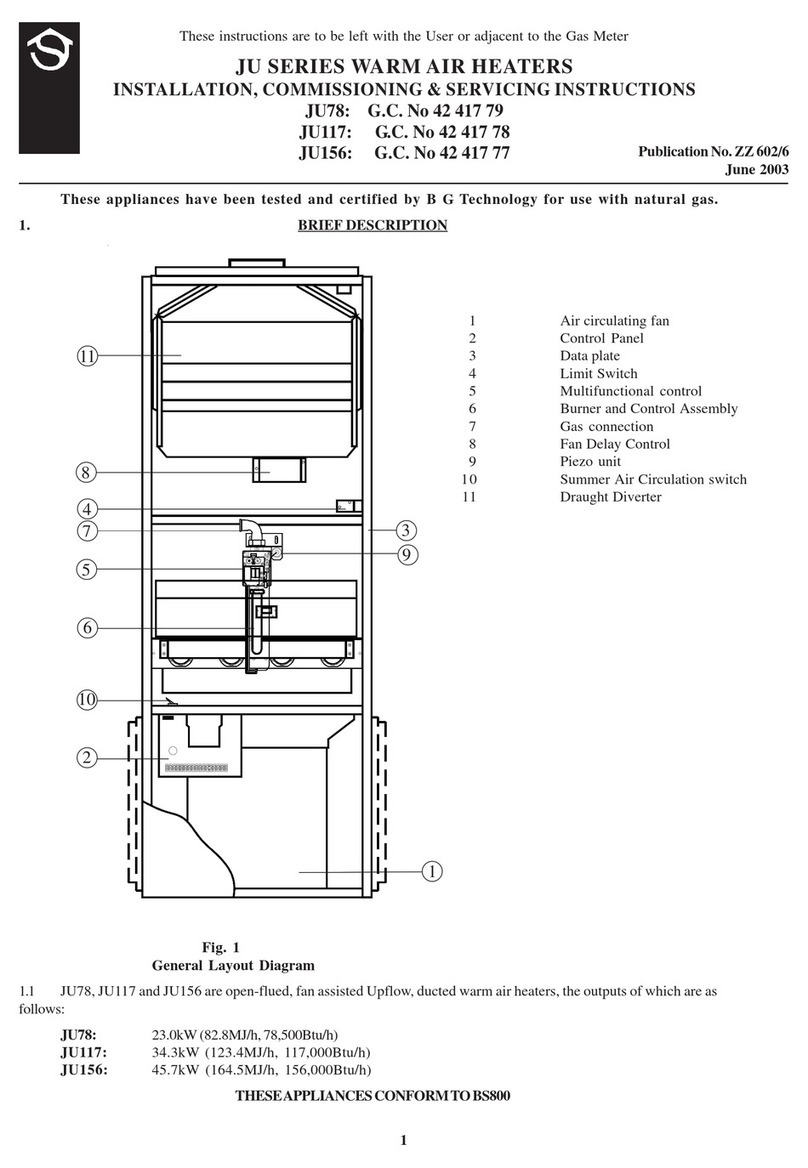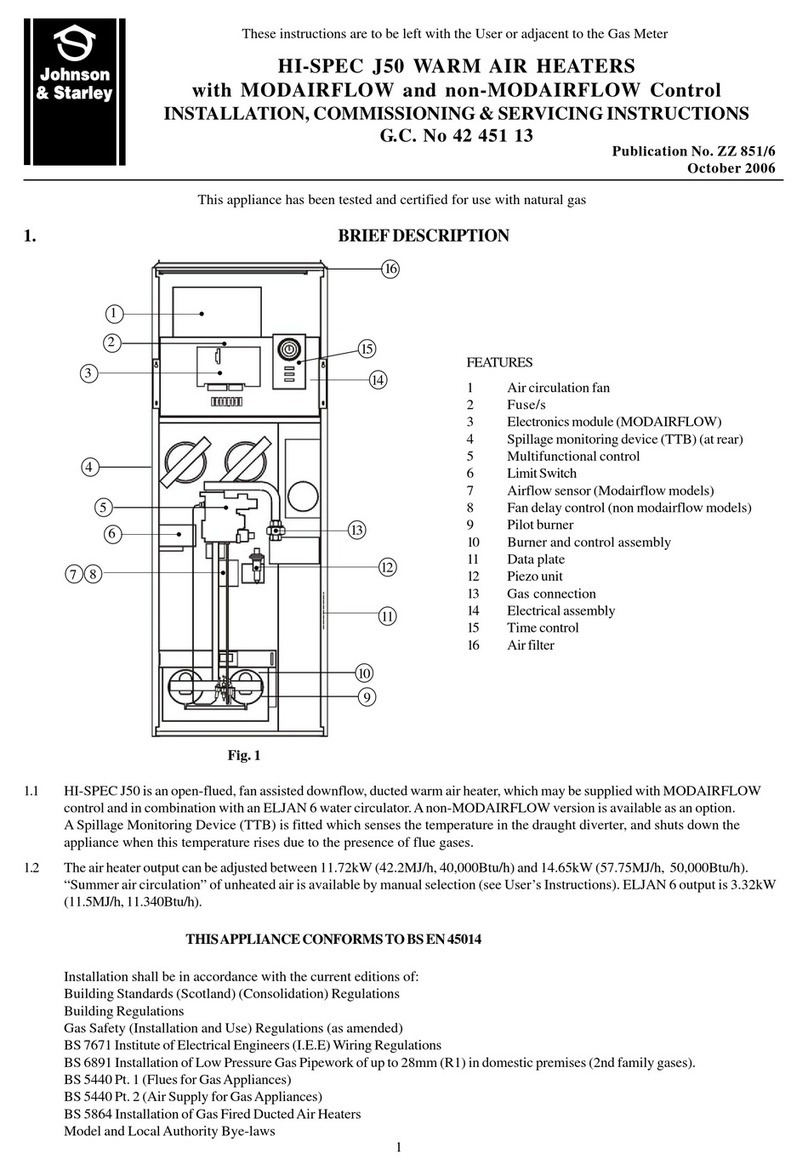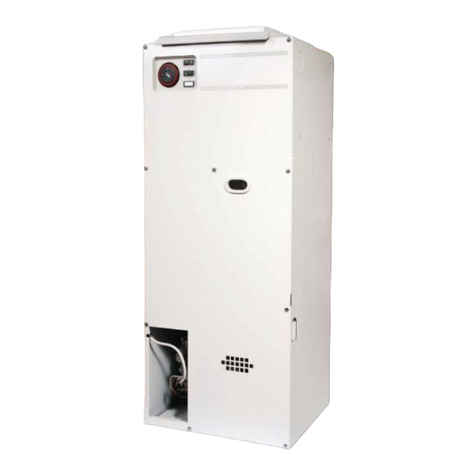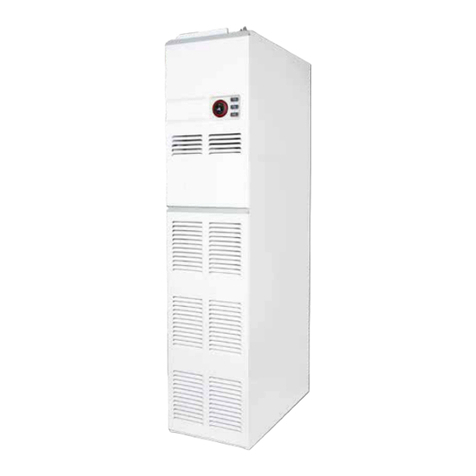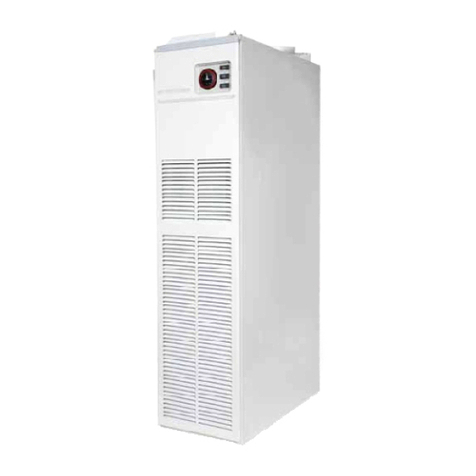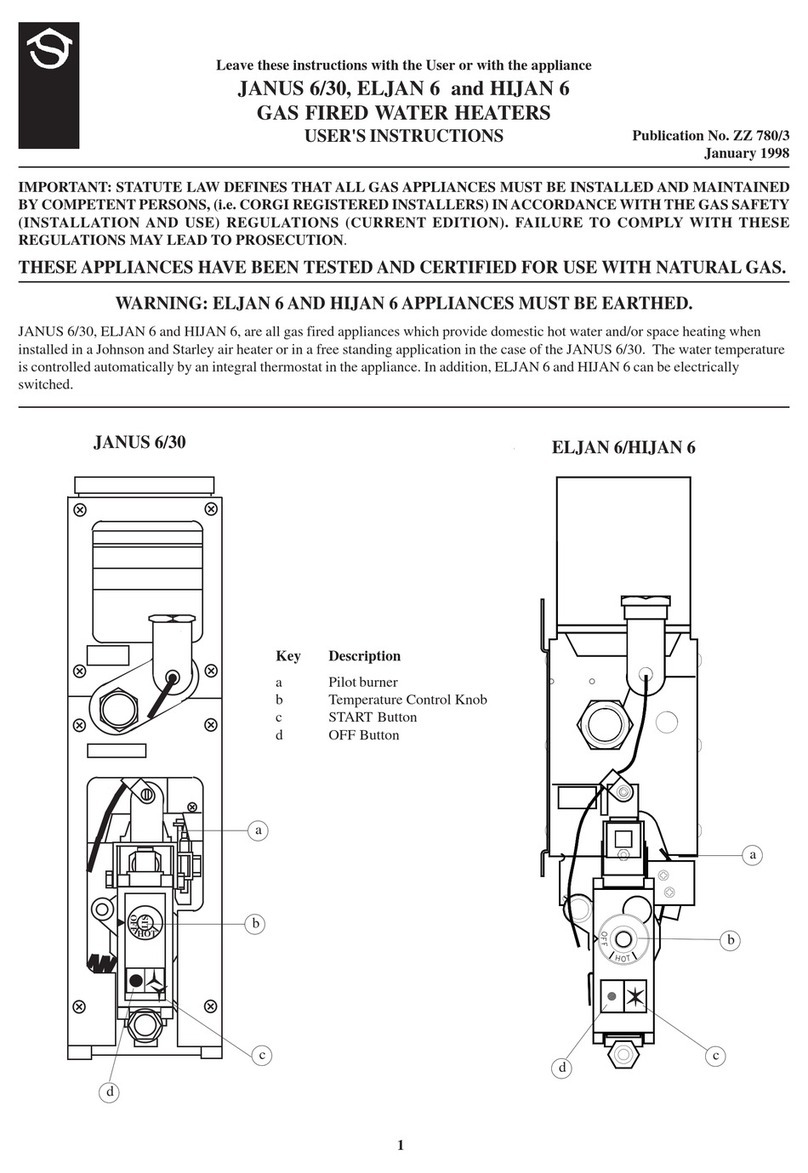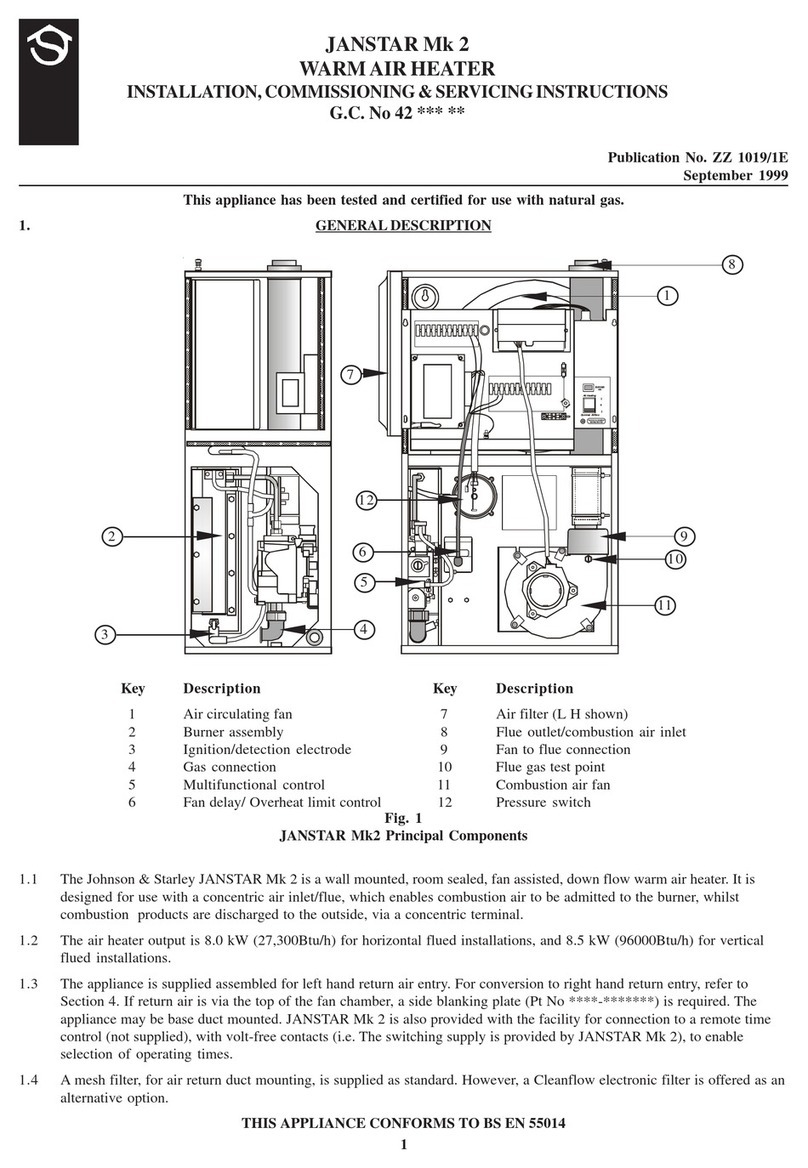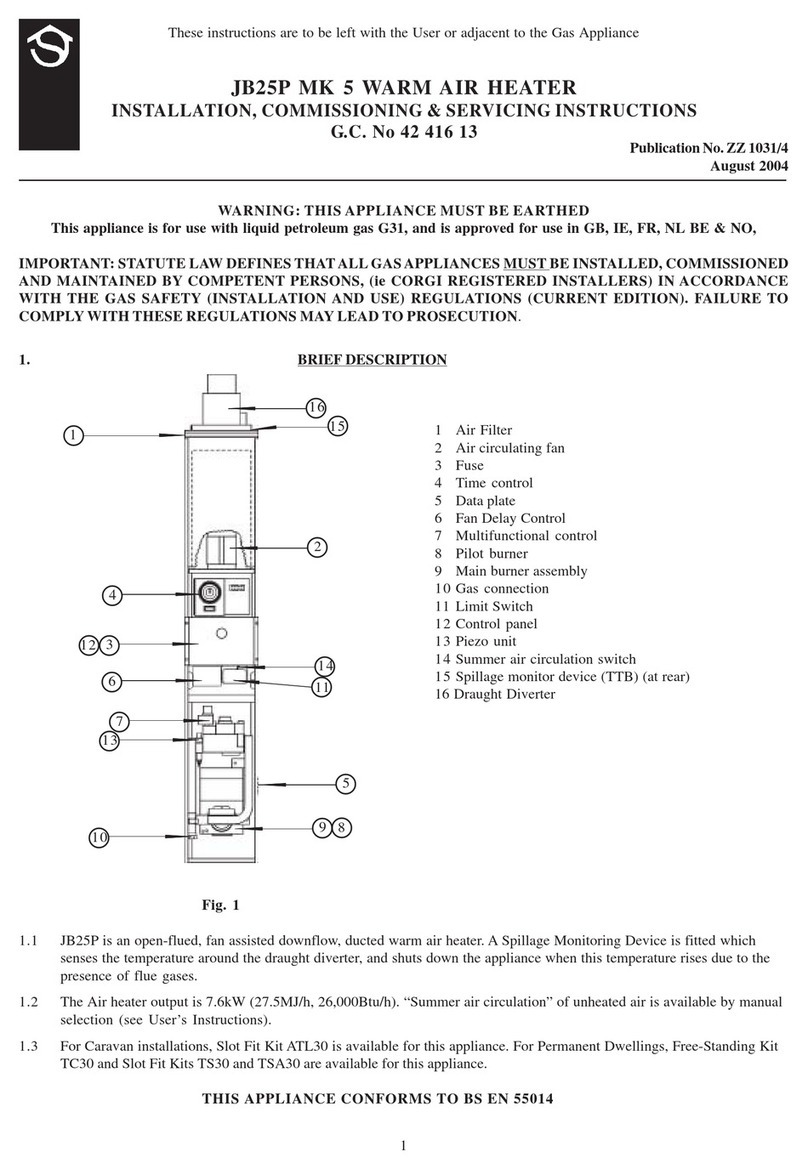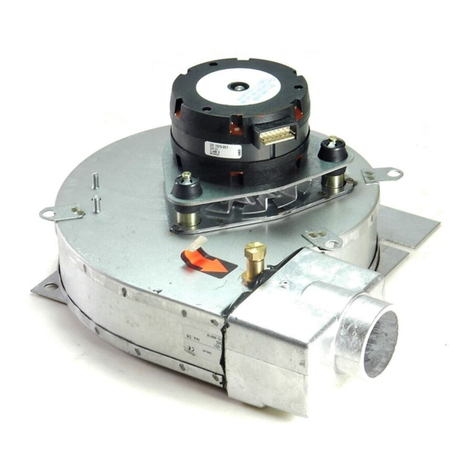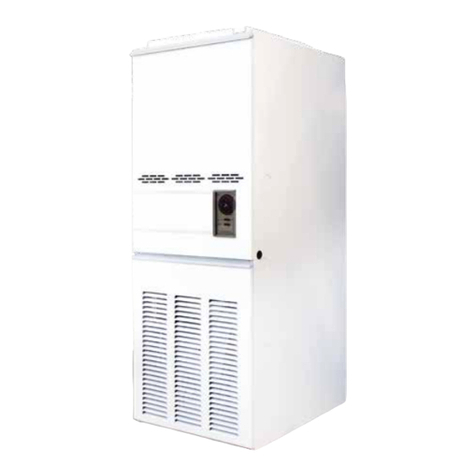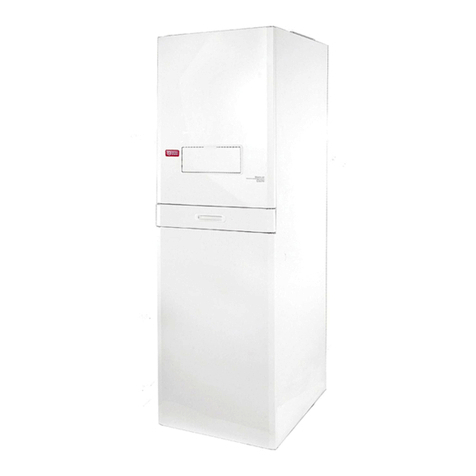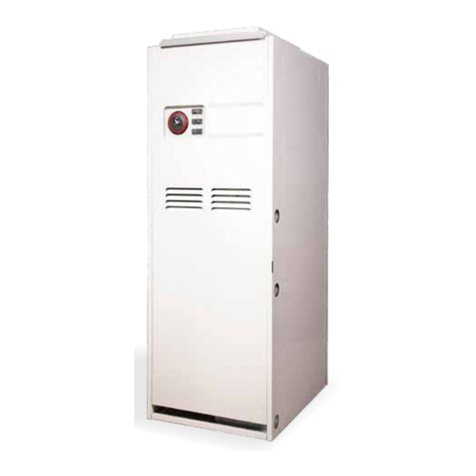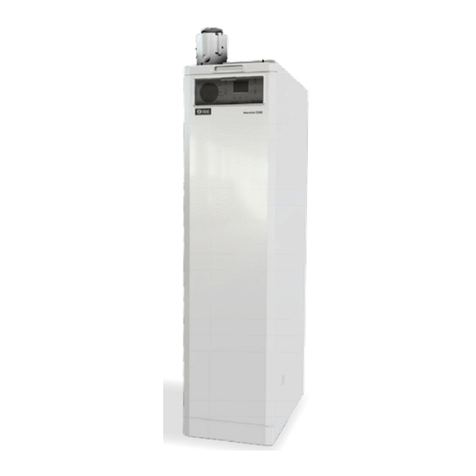
227
1.2 The air heater output can be adjusted between 5.6kW (20.0MJ/h, 19,000 Btu/h) and 7.3kW (26.4MJ/h, 25,000 Btu/h) “summer
air circulation” of unheated air is available by manual selection (see the user’s instructions). INTEJAN output is 3.5kW
(12.6MJ/h;11,900Btu/h).
Installation shall be in accordance with the current editions of:
Building Standards (Scotland) (Consolidation) Regulations
Building Regulations
Gas Safety (Installation and Use) Regulations (as amended)
BS 7671 Institute of Electrical Engineers (I.E.E.) Wiring Regulations
BS 6891 Installation of Low Pressure Gas Pipework of up to 28mm (R1) in domestic premises (2nd family gases).
BS 5440 Pt. 1 (Flues for GasAppliances)
BS 5440 Pt. 2 (Air Supply for GasAppliances)
BS 5864 Installation of Gas Fired DuctedAir Heaters
British System Design Manual “Gas Fired Warm Air Heating”
Model and Local Authority Bye-laws
BS 5546 Installation of Domestic Hot Water Supplies.
IMPORTANT:ITISASTATUTORYREQUIREMENTTHATALLGASAPPLIANCESAREINSTALLED BYCOMPETENT
PERSONS,(i.e.CORGIREGISTEREDINSTALLERS)INACCORDANCEWITHTHEGASSAFETY(INSTALLATIONANDUSE)
REGULATIONS(CURRENTEDITION).FAILURETOCOMPLYWITHTHESEREGULATIONSMAYLEADTOPROSECUTION.
1.3 TECHNICALDATA
ECONOMAIRE 25 ECONOMAIRE 25 INTEJAN
Weight: 45 Kg 51.5 Kg
Air Heater Water Circulator
Gas G20
Gas Supply Pressure 20mbar
Gas Category I 2H
Countries of Installation GB & IE
Electrical Supply 230 ~ 50Hz fused 5A 165W
Nox Class 1
Max Water Side Operating
pressure (PMS) N/A 1bar
OpenVented System N/A Yes
Sealed System N/A No
AIR HEATER WATER CIRCULATOR
LOW RATE HIGH RATE
KW MJ/h Btu/h KW MJ/h Btu/h KW MJ/h Btu/h
INPUT 7.6 27.1 25,780 9.7 35.1 33,250 4.86 17.5 16,600
OUTPUT 5.6 20.0 19,000 7.3 26.4 25,000 3.5 12.6 11,900
Gas rate cv
1037Btu/ft30.7m3/h (24.9ft3/h) 0.91m3/h (32.1ft3/h) 0.458m3/h (16.2ft3/h)
Burner setting
pressure (hot) 10.0mbar (4.0 in wg) 17.0mbar (6.8 in wg) 15.0mbar (6.0 in wg)
Main Injector Bray Cat 33/700 Amal 187/001/400
SERVICE INTERVAL RECORD
It is recommended that your heating system is serviced regularly and that your service engineer completes the
appropriate service interval record below.
SERVICE PROVIDER
Before completing the appropriate service interval record below, please ensure that you have carried out the service
as described in the heater manufacturer’s instructions and in compliance with the Gas Safety Regulations
SERVICE1 Date . . . . . . . . . . . . . . . . . . .
Engineer’sName . . . . . . . . . . . . . . . . . . . . . . . . . . . . . . . . . .
Company Name . . . . . . . . . . . . . . . . . . . . . . . . . . . . . . . . . . .
Tel No . . . . . . . . . . . . . . . . . . . . . . . . . . . . . . . . . . . . . . . . . . .
CORGI ID Serial No . . . . . . . . . . . . . . . . . . . . . . . . . . . . . . . .
Comments . . . . . . . . . . . . . . . . . . . . . . . . . . . . . . . . . . . . . . . .
Signature . . . . . . . . . . . . . . . . . . . . . . . . . . . . . . . . . . . . . . . . .
SERVICE2 Date . . . . . . . . . . . . . . . . . . .
Engineer’sName . . . . . . . . . . . . . . . . . . . . . . . . . . . . . . . . . .
Company Name . . . . . . . . . . . . . . . . . . . . . . . . . . . . . . . . . . .
Tel No . . . . . . . . . . . . . . . . . . . . . . . . . . . . . . . . . . . . . . . . . . .
CORGI ID Serial No . . . . . . . . . . . . . . . . . . . . . . . . . . . . . . . .
Comments . . . . . . . . . . . . . . . . . . . . . . . . . . . . . . . . . . . . . . . .
Signature . . . . . . . . . . . . . . . . . . . . . . . . . . . . . . . . . . . . . . . . .
SERVICE3 Date . . . . . . . . . . . . . . . . . . .
Engineer’sName . . . . . . . . . . . . . . . . . . . . . . . . . . . . . . . . . .
Company Name . . . . . . . . . . . . . . . . . . . . . . . . . . . . . . . . . . .
Tel No . . . . . . . . . . . . . . . . . . . . . . . . . . . . . . . . . . . . . . . . . . .
CORGI ID Serial No . . . . . . . . . . . . . . . . . . . . . . . . . . . . . . . .
Comments . . . . . . . . . . . . . . . . . . . . . . . . . . . . . . . . . . . . . . . .
Signature . . . . . . . . . . . . . . . . . . . . . . . . . . . . . . . . . . . . . . . . .
SERVICE4 Date . . . . . . . . . . . . . . . . . . .
Engineer’sName . . . . . . . . . . . . . . . . . . . . . . . . . . . . . . . . . .
Company Name . . . . . . . . . . . . . . . . . . . . . . . . . . . . . . . . . . .
Tel No . . . . . . . . . . . . . . . . . . . . . . . . . . . . . . . . . . . . . . . . . . .
CORGI ID Serial No . . . . . . . . . . . . . . . . . . . . . . . . . . . . . . . .
Comments . . . . . . . . . . . . . . . . . . . . . . . . . . . . . . . . . . . . . . . .
Signature . . . . . . . . . . . . . . . . . . . . . . . . . . . . . . . . . . . . . . . . .
SERVICE5 Date . . . . . . . . . . . . . . . . . . .
Engineer’sName . . . . . . . . . . . . . . . . . . . . . . . . . . . . . . . . . .
Company Name . . . . . . . . . . . . . . . . . . . . . . . . . . . . . . . . . . .
Tel No . . . . . . . . . . . . . . . . . . . . . . . . . . . . . . . . . . . . . . . . . . .
CORGI ID Serial No . . . . . . . . . . . . . . . . . . . . . . . . . . . . . . . .
Comments . . . . . . . . . . . . . . . . . . . . . . . . . . . . . . . . . . . . . . . .
Signature . . . . . . . . . . . . . . . . . . . . . . . . . . . . . . . . . . . . . . . . .
SERVICE6 Date . . . . . . . . . . . . . . . . . . .
Engineer’sName . . . . . . . . . . . . . . . . . . . . . . . . . . . . . . . . . .
Company Name . . . . . . . . . . . . . . . . . . . . . . . . . . . . . . . . . . .
Tel No . . . . . . . . . . . . . . . . . . . . . . . . . . . . . . . . . . . . . . . . . . .
CORGI ID Serial No . . . . . . . . . . . . . . . . . . . . . . . . . . . . . . . .
Comments . . . . . . . . . . . . . . . . . . . . . . . . . . . . . . . . . . . . . . . .
Signature . . . . . . . . . . . . . . . . . . . . . . . . . . . . . . . . . . . . . . . . .
SERVICE7 Date . . . . . . . . . . . . . . . . . . .
Engineer’sName . . . . . . . . . . . . . . . . . . . . . . . . . . . . . . . . . .
Company Name . . . . . . . . . . . . . . . . . . . . . . . . . . . . . . . . . . .
Tel No . . . . . . . . . . . . . . . . . . . . . . . . . . . . . . . . . . . . . . . . . . .
CORGI ID Serial No . . . . . . . . . . . . . . . . . . . . . . . . . . . . . . . .
Comments . . . . . . . . . . . . . . . . . . . . . . . . . . . . . . . . . . . . . . . .
Signature . . . . . . . . . . . . . . . . . . . . . . . . . . . . . . . . . . . . . . . . .
SERVICE8 Date . . . . . . . . . . . . . . . . . . .
Engineer’sName . . . . . . . . . . . . . . . . . . . . . . . . . . . . . . . . . .
Company Name . . . . . . . . . . . . . . . . . . . . . . . . . . . . . . . . . . .
Tel No . . . . . . . . . . . . . . . . . . . . . . . . . . . . . . . . . . . . . . . . . . .
CORGI ID Serial No . . . . . . . . . . . . . . . . . . . . . . . . . . . . . . . .
Comments . . . . . . . . . . . . . . . . . . . . . . . . . . . . . . . . . . . . . . . .
Signature . . . . . . . . . . . . . . . . . . . . . . . . . . . . . . . . . . . . . . . . .
SERVICE9 Date . . . . . . . . . . . . . . . . . . .
Engineer’sName . . . . . . . . . . . . . . . . . . . . . . . . . . . . . . . . . .
Company Name . . . . . . . . . . . . . . . . . . . . . . . . . . . . . . . . . . .
Tel No . . . . . . . . . . . . . . . . . . . . . . . . . . . . . . . . . . . . . . . . . . .
CORGI ID Serial No . . . . . . . . . . . . . . . . . . . . . . . . . . . . . . . .
Comments . . . . . . . . . . . . . . . . . . . . . . . . . . . . . . . . . . . . . . . .
Signature . . . . . . . . . . . . . . . . . . . . . . . . . . . . . . . . . . . . . . . . .
SERVICE10 Date . . . . . . . . . . . . . . . . . . .
Engineer’sName . . . . . . . . . . . . . . . . . . . . . . . . . . . . . . . . . .
Company Name . . . . . . . . . . . . . . . . . . . . . . . . . . . . . . . . . . .
Tel No . . . . . . . . . . . . . . . . . . . . . . . . . . . . . . . . . . . . . . . . . . .
CORGI ID Serial No . . . . . . . . . . . . . . . . . . . . . . . . . . . . . . . .
Comments . . . . . . . . . . . . . . . . . . . . . . . . . . . . . . . . . . . . . . . .
Signature . . . . . . . . . . . . . . . . . . . . . . . . . . . . . . . . . . . . . . . . .
When all of the above services have been completed, please contact your service engineer for an additional
service record sheet.
